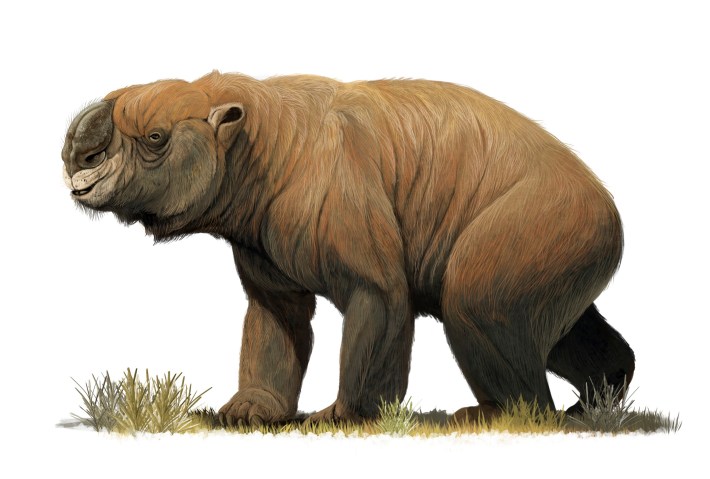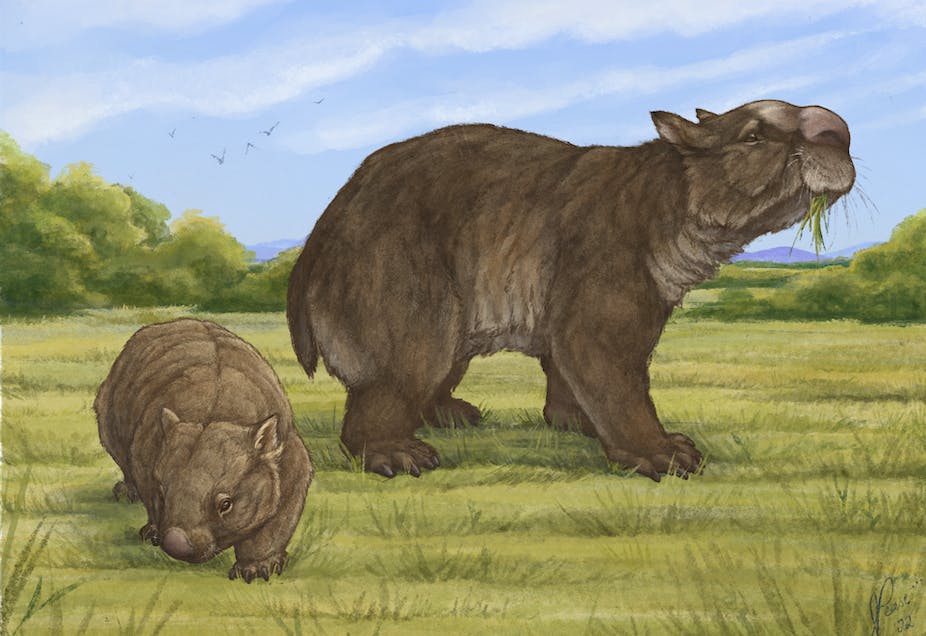In 2017, Australia mourned when Patrick the 32-year-old virgin wombat passed away at a wildlife park. Patrick, the oldest known bare-nosed wombat in the world, first came to the park an orphan after his mother was hit by a car in 1987. Caretakers attempted to release Patrick into the wild several times, only to find the tender young wombat "brutalized by other wombats," according to a story in HuffPost. Luckily, Patrick survived the encounters. Deemed "too soft" to live in the wild, Patrick spent the rest of his life riding around in a wheelbarrow, cuddling, and eating freshly picked grass in the wildlife park.
It's fortunate that Patrick the late and dearly beloved wombat never encountered his prehistoric predecessors: the giant wombats that roamed Australia thousands of years ago. Patrick would never have stood a chance against Phascolonus (the size of a cow), Sedophascolomys (the size of a goat), and finally Ramsayia (the size of a sheep). These seriously giant wombats would have absolutely pummeled poor Patrick, may his large soul rest in peace.
The sheep-sized Ramsayia was the most mysterious of the triad of giant wombats, known mostly from fragments of its fossilized teeth and jaws. But now, paleontologists have unearthed and described the most complete skull of the giant wombat Ramsayia, shedding new light on an ancient tank-like marsupial. The team published their results on Dec. 12 in the journal Papers in Palaeontology.
The Ramsayia skull, which was first uncovered in the Mount Etna caves in Queensland in the early 2000s, represents the most compete specimen of the species. This particular giant wombat roamed Australia around 80,000 years ago. Its facial structure was unusual, with a large, rounded skull with prominent sinuses. A head and sinuses this big would have allowed Ramsayia to develop larger chewing muscles and process lower-quality vegetation than other wombats.
It is always exciting to know more about prehistoric big boys and how they may have chomped, grazed, and swallowed. But perhaps the most exciting thing about this newly described skull is its premaxillary spine, which is a kind of vertical bony spine that would have supported a "large fleshy nose," the authors write. This is the kind of prehistoric detail I live for—a chance to imagine a Ramsayia sniffing out a prehistoric Australian gourd with its plush, pliable nose in the style of Tilli the aardvark.
I've often felt jealous of Australia's monopoly on wombats, sugar gliders, and other cool marsupials. I know that I am not alone in this, or in my belief that North American mammals better start innovating, evolutionarily speaking. Fellow wombat fans might be reading this blog and wondering, at this point, what about Australia's most famous giant wombat, the largest marsupial that ever lived? What about Diprotodon?

True wombat sickos know that Diprotodon, despite appearances, is not a "true" wombat. The prehistoric wombat-like creature does not belong to the modern wombat family, Vombatidae. Calling Diprotodon a wombat is the "equivalent to saying a hippo is just a giant pig," Julien Louys, a paleontologist from Griffith's Australian Research Center for Human Evolution and author on the new paper, said in a press release.
Taxonomy can be tricky, especially in its unintentionally savage deployment of the word "true." "True seals" lack an external ear flap, relegating fur seals to the realm of "eared seals." Similarly, "true bugs" belong to the order Hemiptera, which includes cicadas, leafhoppers, and bed bugs but excludes other insects like bees, beetles, and butterflies. Thinking too hard about these distinctions becomes almost an exercise in philosophy. Are these bugs any less true? What is a wombat?
Taxonomists may hate me for this, but to me, the marker of a true wombat is not belonging in the family Vombatidae, or even living in Australia. The mark of a true wombat is pooping cubes. Wombats are the only species to poop cubes. The bare-nosed wombat plops out nearly 100 turd cubes every day, according to this story in the revered publication Science. Just look at this romantic art composed using the poop cubes of Patrick the wombat two years before his death. Taxonomy be damned; if Diprotodon could poop cubes, it would be a wombat in my book.






